This soft and tender simmered daikon has the perfect balance of savoury and sweet flavour. Braised in a lightly flavoured dashi stock, it’s perfect as an appetiser or side to your favourite Japanese recipes!
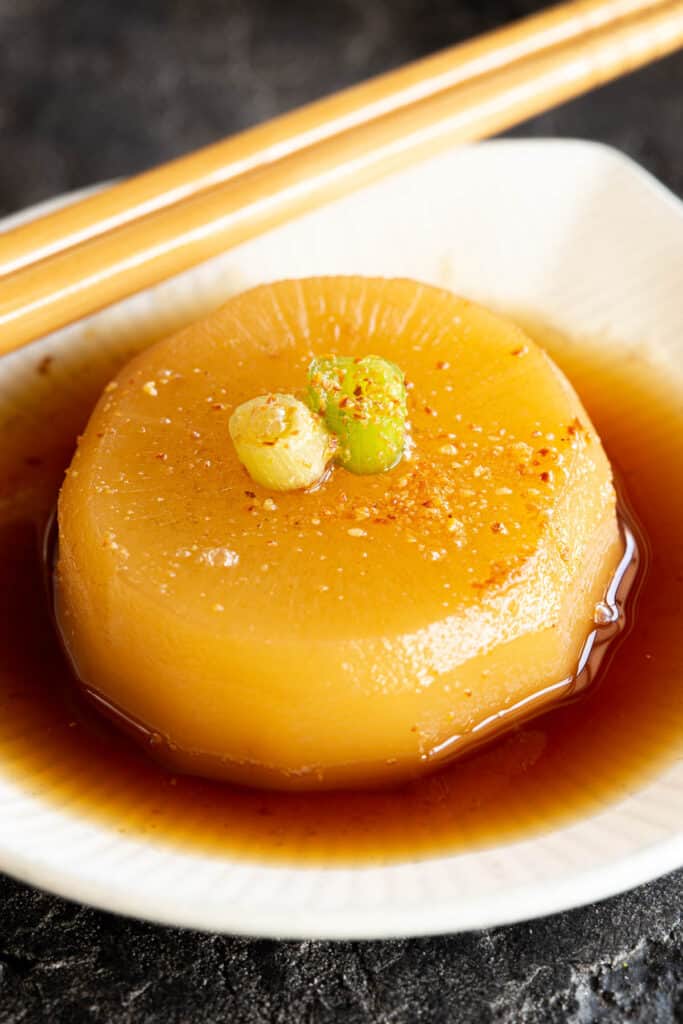
In This Post You’ll Learn
Why We Love This
Simmered daikon is an easy Japanese appetiser that’s made with a simple shiru broth of dashi stock, soy sauce, mirin and cooking sake.
Whether you want to enjoy it hot or cold, it’s deliciously satisfying while staying light on the tummy.
It has minimal prep and is mostly hands-off cooking, so you can be doing other things while it bubbles away on the stove – win win!
Related: Japanese Oden / Takuan / Easy Daikon Recipes
Why Round Out the Edges of Your Daikon Pieces?
Daikon radish is prone to falling apart when it’s simmered for a long time, since the pieces tend to bump into each other while cooking. To avoid this, you should round out the edges using a peeler or paring knife. This step is known as mentori in Japanese.
Tip: This is a great technique for other veggies like carrots and potatoes in dishes like nikujaga (Japanese beef and potato stew) or even ca ri ga (Vietnamese chicken curry).
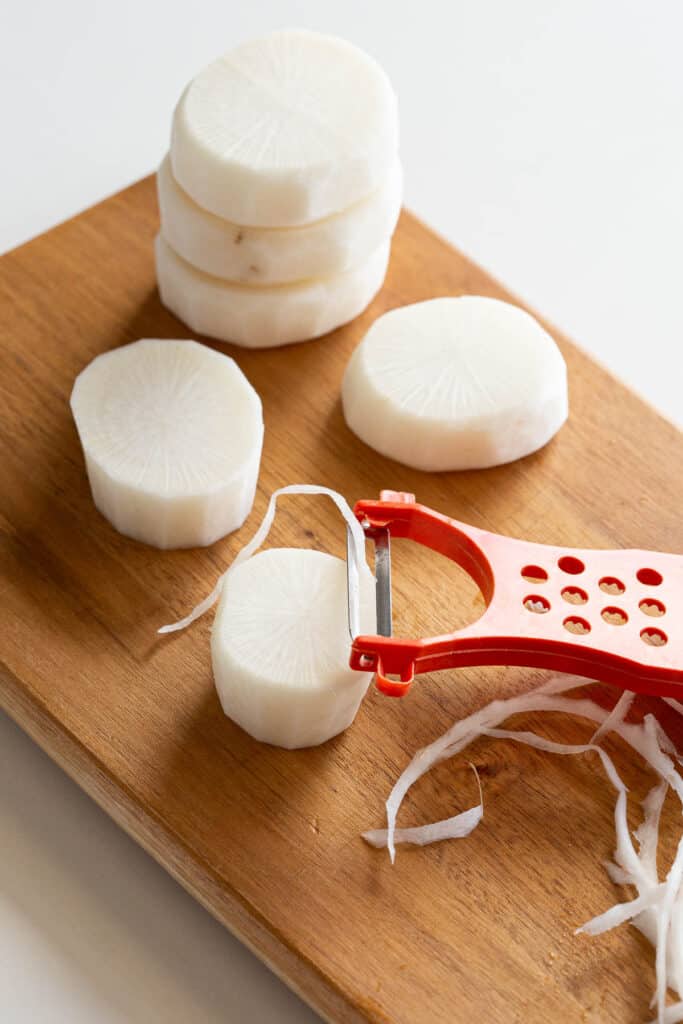
What is Simmered Daikon?
Simmered daikon (also known as daikon no nimono / 大根 の 煮物 or braised daikon) is a type of Japanese simmered dish. Nimono translates as simmered (ni) + things (mo).
Daikon is just one of the vegetables that can be prepared as nimono, other versions are made with lotus root, bamboo, shiitake mushrooms, or even konnyaku blocks.
Daikon no nimono consists of daikon slices that are slowly simmered in a lightly flavoured broth of dashi stock seasoned with soy sauce, sake and mirin. It’s usually served as a side dish for lunch or dinner in Japan.
What You’ll Need
- Daikon Radish – Daikon is a type of long white radish popular across many Asian cuisines, especially Japanese, Korean and Vietnamese. You’ll need around 500 g / 1 lb for this recipe.
- Dashi Stock – Make your own dashi stock using kombu and/or bonito flakes, or use dashi powder for convenience.
- Soy Sauce – For the best flavour use a Japanese soy sauce such as Kikkoman which has the perfect balance of flavour and salt. Sub with tamari for a gluten-free option.
- Mirin – A sweet rice wine for cooking. If you can’t find it at your supermarket, you can omit or add in a 1/2 tsp of sugar instead. You can sometimes find this in regular supermarkets, otherwise head to your nearest Asian grocer or online.
- Cooking Sake – Another cooking wine, but less sweet. Sub with Chinese cooking wine, sherry or a blend of 50:50 vodka and water in a pinch.
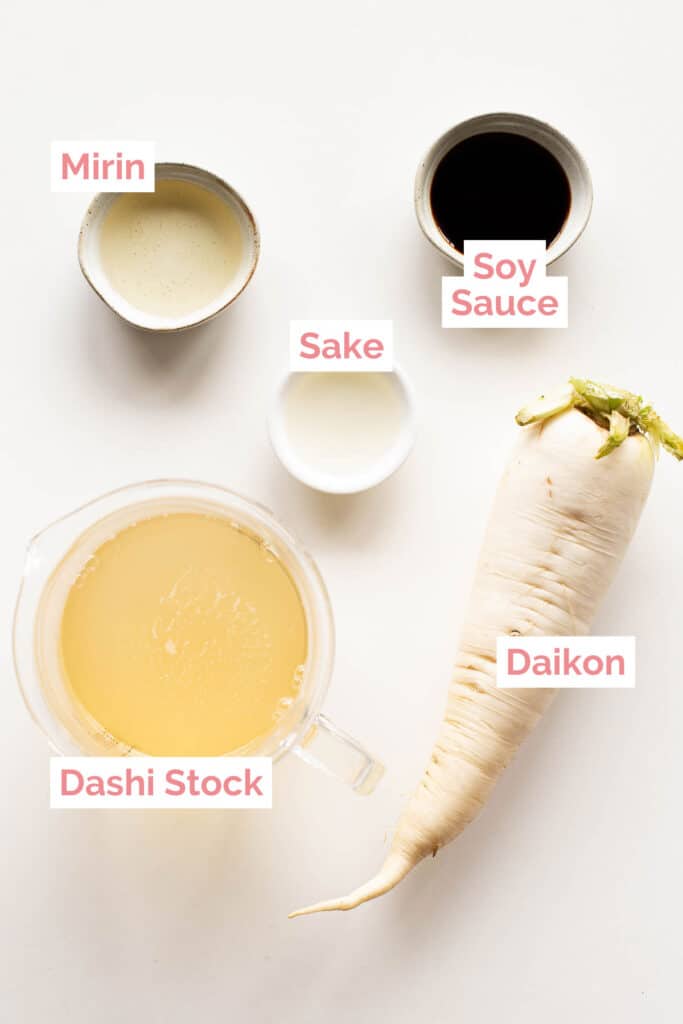
How to Make Daikon No Nimono
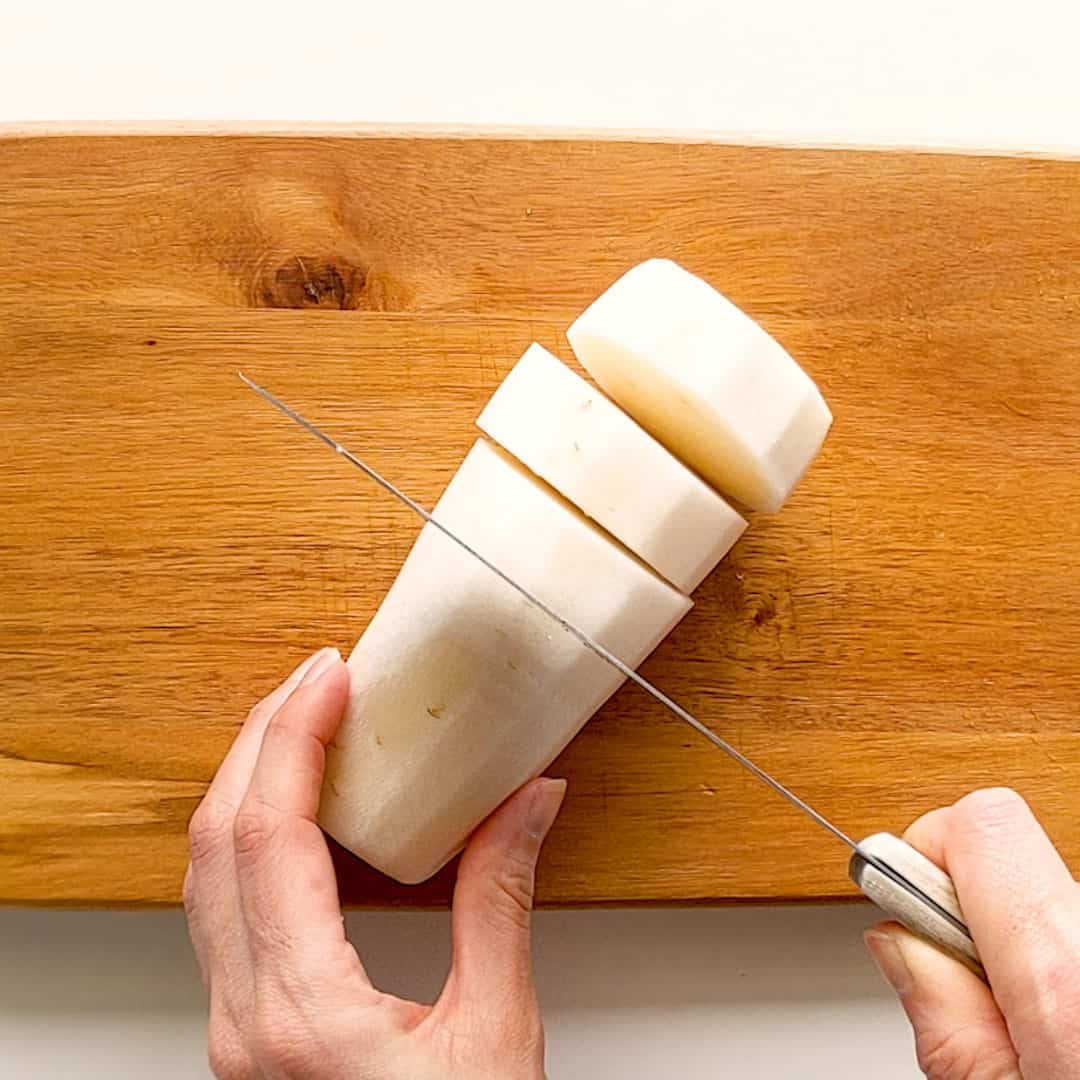
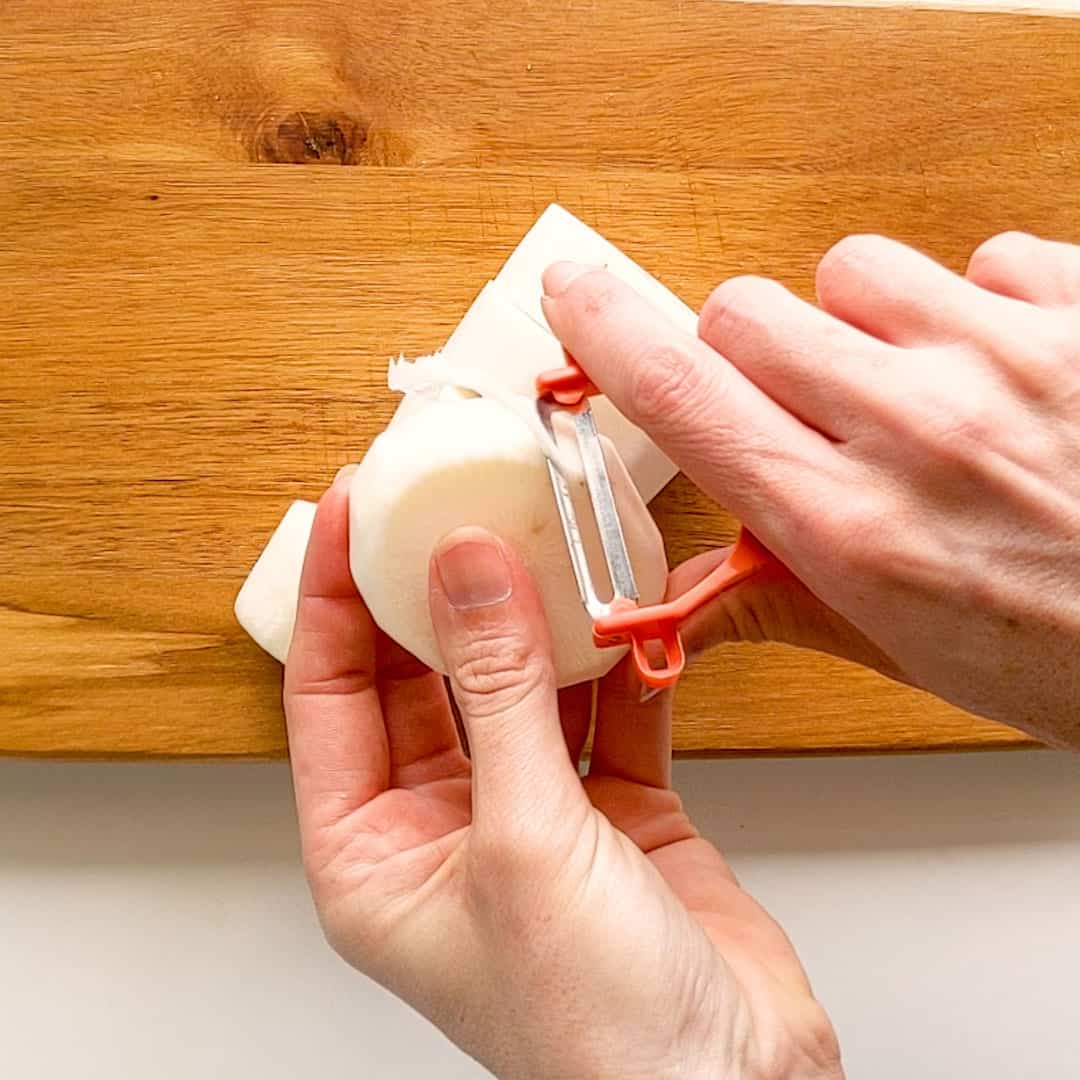
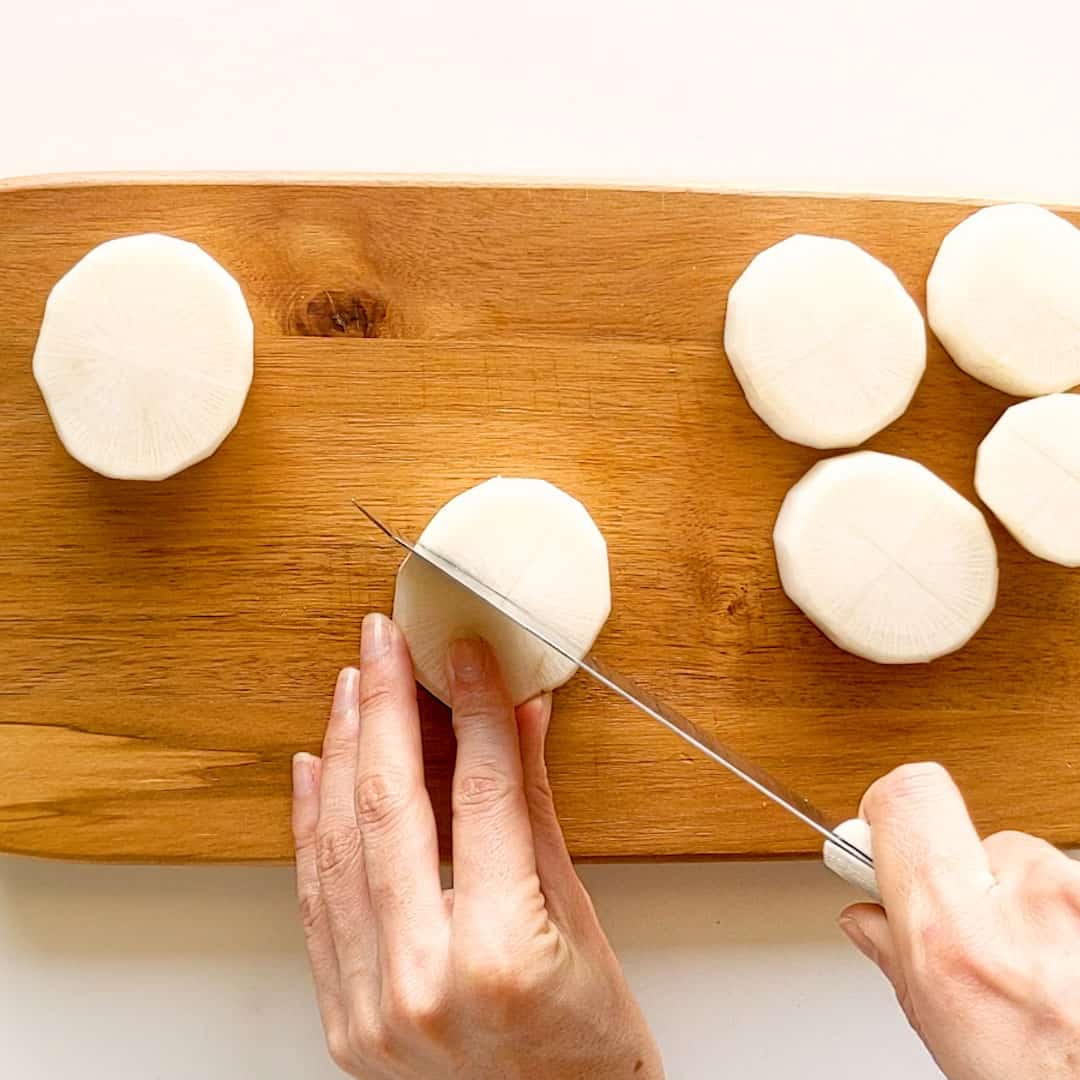
- Peel the daikon, and cut into 6-8 thick rounds (around 2 cm / 0.8 in thick). It’s important to get the same thickness for each piece.
- Gently peel off the edges of each daikon piece to “round it off” and avoid them breaking up while cooking.
- Next, slice a cross into one side of the daikon pieces, around ⅓ – ½ of the way down. This will help the daikon cook faster and absorb more flavour.
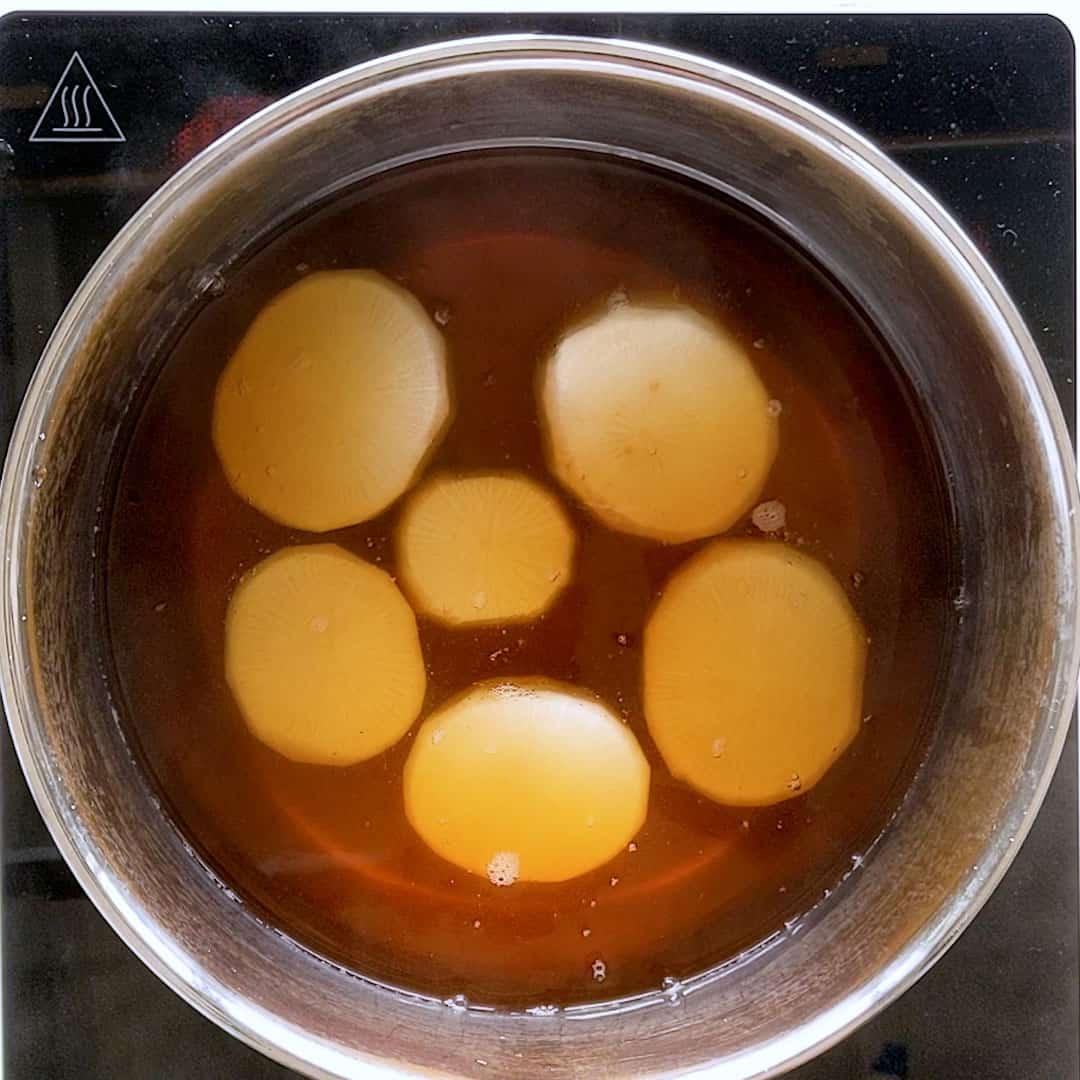
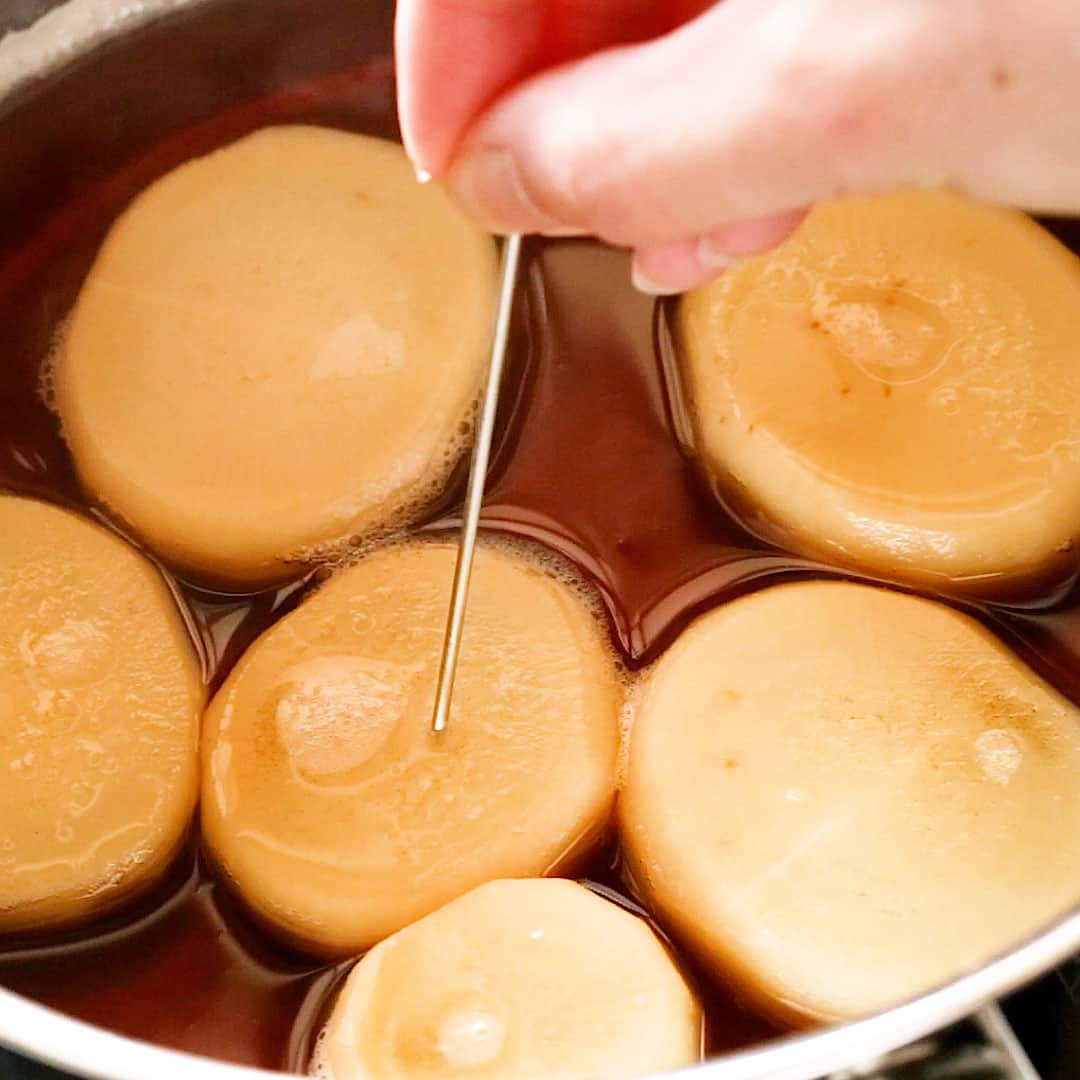
- Place the daikon pieces, cross face down, into a medium saucepan. Pour in the soy sauce, mirin, cooking sake and dashi stock. You want the dashi to cover the daikon, so add a little more if required depending on the size of your pan.2 cups dashi stock,1.5 tbsp soy sauce,2 tbsp mirin,1 tbsp sake
- Bring to the boil for 10 minutes, then reduce to a simmer for 30 min – 1 hour or until the daikon is soft. You can test the softness of the daikon with a skewer.
- Serve immediately and ladle over one or two spoons of the broth, or re-heat the next day for even more infused flavour!
Full recipe with measurements in the recipe card below.
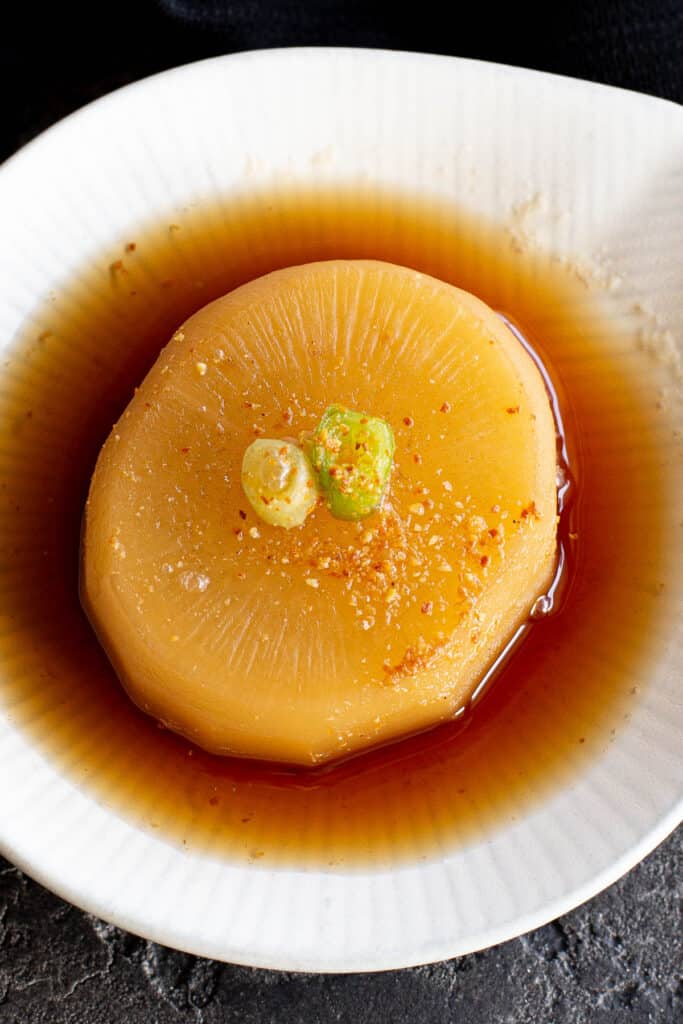
Wandercook’s Tips
- Slicing the Daikon – Aim for uniform thickness when slicing the daikon into disks – around 2cm / 1 inch thick. This will help them cook evenly and ensure they have the same level of softness by the end of your cooking time.
- Simmering Time – The longer you simmer the daikon, the softer and more translucent it will become, and the more the flavours in the broth will infuse into the centre of each piece.
FAQs
As an individual dish, this simmered daikon recipe is perfect on its own or with a dab of karashi mustard or yuzu kosho (citrus chilli paste) on the side of the bowl, and optional shichimi togarashi sprinkled over the top. You can also top it with nikumiso meat sauce.
As a side dish, try it alongside dishes like cooked rice, ganmodoki tofu patties, and kinpira gobo.
Try slicing up the simmered daikon and adding it to your next batch of miso soup!
You sure can, and it will taste even better the next day! Simmered daikon will last around 3-4 days in the fridge if stored in an airtight container.
Variations
- Add Umami – Try it with a scoop of miso paste blended into the broth once you’ve finished cooking.
- Garnish Ideas – Serve the daikon slices on small plates drizzled with broth and your favourite garnishes like gomashio sesame salt, toasted sesame seeds, or thinly sliced spring onion / green onion.
- Add More – Want more than just daikon? Feel free to add carrot, potato or tofu to the mix!
- Leftovers? – Add them to a batch of Japanese vegetable soup (kenchinjiru).
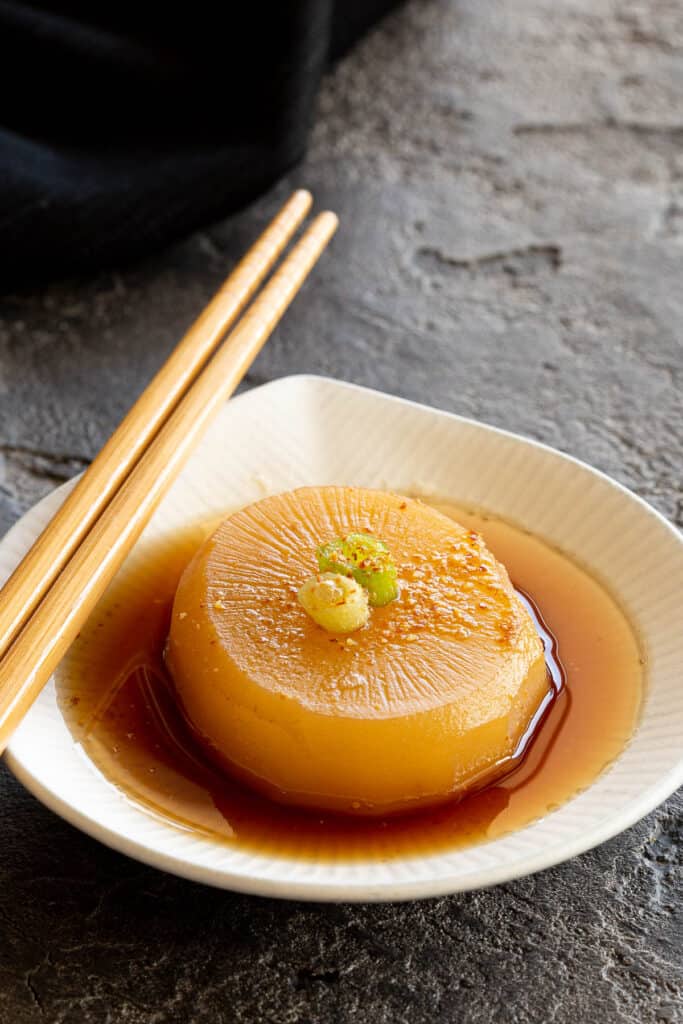
Try these delicious recipes next:
★ Did you make this recipe? Please leave a comment and a star rating below!
Ingredients
- 1 daikon radish around 500 g / 1 lb
- 2 cups dashi stock
- 1.5 tbsp soy sauce
- 2 tbsp mirin
- 1 tbsp sake
Instructions
- Peel the daikon, and cut into 6-8 thick rounds (around 2 cm / 0.8 in thick). It’s important to get the same thickness for each piece.1 daikon radish
- Gently peel off the edges of each daikon piece to “round it off” and avoid them breaking up while cooking. Next, slice a cross into one side of the daikon pieces, around ⅓ – ½ of the way down. This will help the daikon cook faster and absorb more flavour.
- Place the daikon pieces, cross face down, into a medium saucepan. Pour in the soy sauce, mirin, cooking sake and dashi stock. You want the dashi to cover the daikon, so add a little more if required depending on the size of your pan.2 cups dashi stock, 1.5 tbsp soy sauce, 2 tbsp mirin, 1 tbsp sake
- Bring to the boil for 10 minutes, then reduce to a simmer for 30 min – 1 hour or until the daikon is soft. You can test the softness of the daikon with a skewer.
- Serve immediately and ladle over one or two spoons of the broth, or re-heat the next day for even more infused flavour!
Video
Recipe Notes
- Slicing the Daikon – Aim for uniform thickness when slicing the daikon into disks – around 2cm / 1 inch thick. This will help them cook evenly and ensure they have the same level of softness by the end of your cooking time.
- Simmering Time – The longer you simmer the daikon, the softer and more translucent it will become, and the more the flavours in the broth will infuse into the centre of each piece.
- Add Umami – Try it with a scoop of miso paste blended into the broth once you’ve finished cooking.
- Garnish Ideas – Serve the daikon slices on small plates drizzled with broth and your favourite garnishes like gomashio sesame salt, toasted sesame seeds, or thinly sliced spring onion / green onion.
- Add More – Want more than just daikon? Feel free to add carrot, potato or tofu to the mix!
Nutrition


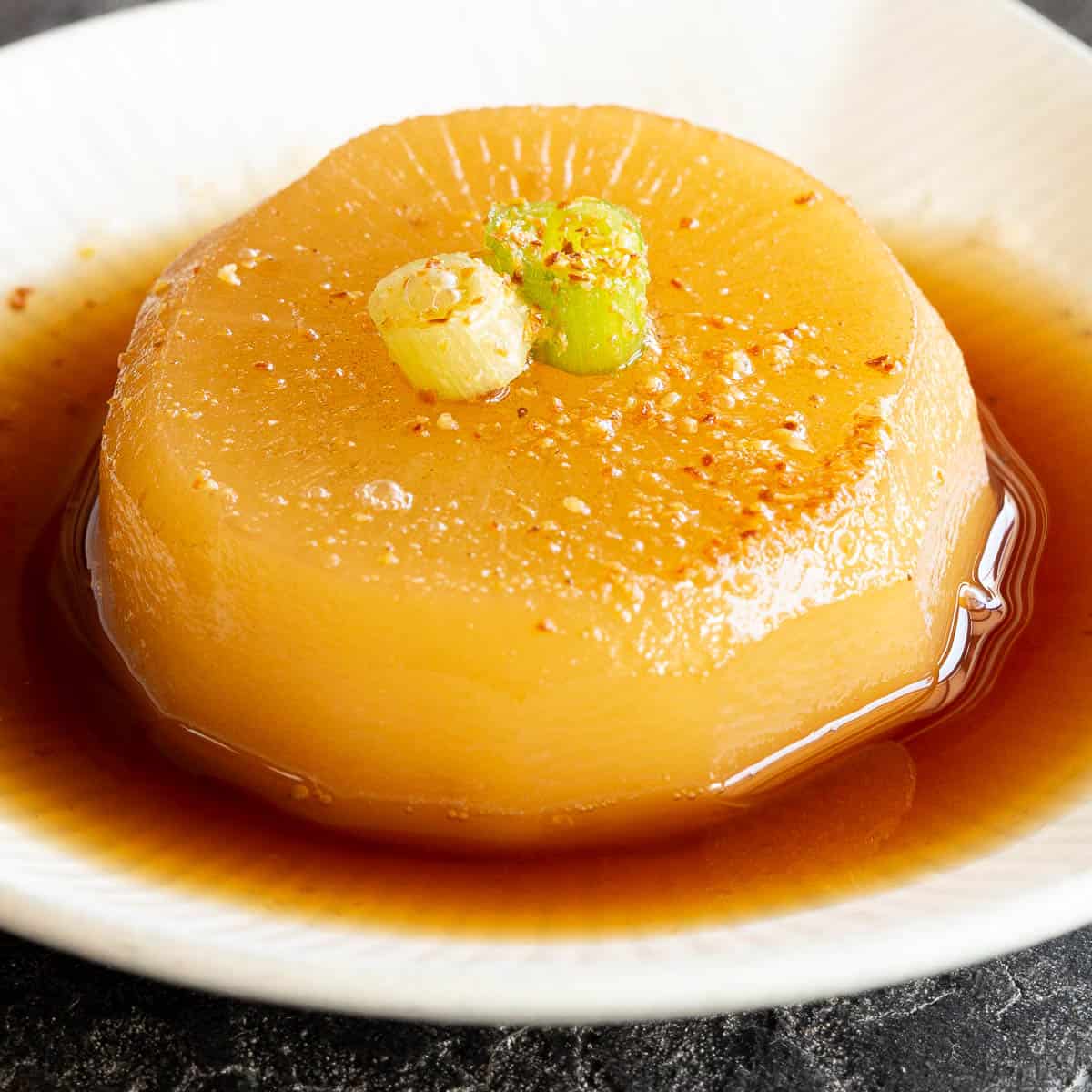



No Comments